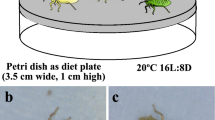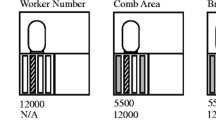Summary
The adaptive origins of the honeybee's age polyethism schedule were studied by testing whether the schedule for labor inside the nest reflects a compromise between efficiency in locating tasks and efficiency in performing tasks. I checked two predictions of this hypothesis: (1) at each age a worker handles a set of tasks (rather than one task), and (2) the elements of each age's task-set co-occur spatially in the nest (rather than being spatially segregated). Most observations match these predictions, once workers reach the age of 2 days. The unpredicted specialization of 0 to 2-day-old workers on the single task of cell cleaning may reflect an unusual ease in locating work sites for this particular task. There are 5 female castes in honeybee colonies: the queen (reproductive caste), plus 4 age subcastes among the workers (cell cleaning caste, broodnest caste, food storage caste, and forager caste).
Similar content being viewed by others
References
Alford DV (1975) Bumblebees. Davis-Poynter, London
Bassindale R (1955) The biology of the stingless bee Trigona (Hypotrigona) gribodoi Magretti. Proc Zool Soc (Lond) 125:49–62
Brian MV (1979) Caste differentiation and division of labor. In: Hermann H (ed) Social insects, vol I. Academic, New York, pp 121–221
Cruz Landim C da, Ferreira A (1968) Mandibular gland development and communication in field bees of Trigona (Scaptotrigona) postica. J Kansas Entomol Soc 41:474–481
Fluri P, Wille H, Gerig L, Lüscher M (1977) Juvenile hormone, vitellogenin and haemocyte composition in winter worker honey bees (Apis mellifera). Experientia 33:1240–1241
Fluri P, Lüscher M, Wille H, Gerig L (1982) Changes in weight of the pharyngeal gland and haemolymph titres of juvenile hormone, protein and vitellogenin in worker honey bees. J Insect Physiol 28:61–68
Free JB (1965) The allocation of duties among worker honeybees. Symp Zool Soc (Lond) 14:39–59
Free JB, Butler CG (1959) Bumblebees. Collins, London
Frisch K von (1967) The dance language and orientation of bees. Harvard University Press, Cambridge, Massachusetts
Gerstung F (1921) Der Bien und seine Zucht. 6. Aufl. Pfenningstorff, Berlin
Hebling NJ, Kerr WE, Kerr FS (1964) Divisão de trabalho entre operárias de Trigona (Scaptotrigona) xanthotricha Moure. Papéis Avulsos Zool (São Paulo) 16:115–127
Imboden H, Lüscher M (1975) Allatektomie bei adulten Bienen-Arbeiterinnen (Apis mellifica). Rev Suisse Zool 82:694–698
Imboden H, Wille H, Gerig L, Lüscher M (1976) Die Vitellogeninsynthese bei der Bienen-Arbeiterin (Apis mellifica) und ihre Abhängigkeit von Juvenilhormon (JH). Rev Suisse Zool 83:928–933
Jaycox ER, Skowronek W, Gwynn G (1974) Behavioral changes in a worker honey bee (Apis mellifera) induced by injections of a juvenile hormone mimic. Ann Entomol Soc Am 67:529–534
Kratky E (1931) Morphologie und Physiologie der Drüsen in Kopf und Thorax der Honigbiene. Z Wiss Zool 139:120–200
Lindauer M (1952) Ein Beitrag zur Frage der Arbeitsteilung im Bienenstaat. Z Vergl Physiol 34:299–345
Lüscher M (1976) Phase and caste determination in insects. Endocrine aspects. Proc XV Int Congr Entomol, Washington, DC, pp 1–4
Michener CD (1964) Evolution of the nests of bees. Am Zool 4:227–239
Michener CD (1974) The social behavior of the bees. A comparative study. Harvard University Press, Cambridge, Massachusetts
Oster GF, Wilson EO (1978) Caste and ecology in the social insects. Princeton University Press, Princeton
Rösch GA (1925) Untersuchungen über die Arbeitsteilung im Bienenstaat, I. Z Vergl Physiol 2:571–631
Rösch GA (1927) Über die Bautätigkeit im Bienenvolk und das Alter der Baubienen. Z Vergl Physiol 6:264–298
Rösch GA (1930) Untersuchungen über die Arbeitsteilung im Bienenstaat, II. Z Vergl Physiol 12:1–71
Rutz W, Gerig L, Wille H, Lüscher M (1974) A bioassay for juvenile hormone (JH) effects of insect growth regulators (IGR) on adult worker honeybees. Mitt Schweiz Entomol Ges 47:307–313
Rutz W, Gerig L, Wille H, Lüscher M (1976) The function of juvenile hormone in adult worker honeybees, Apis mellifera. J Insect Physiol 22:1485–1491
Sakagami SF (1953) Untersuchungen über die Arbeitsteilung in einem Zwergvolk der Honigbiene. Beiträge zur Biologie des Bienenvolkes, Apis mellifica L. I. Jpn J Zool 11:117–185
Seeley TD (1979) Queen substance dispersal by messenger workers in honey bee colonies. Behav Ecol Sociobiol 5:391–415
Wille A, Michener CD (1973) The nest architecture of stingless bees with special reference to those of Costa Rica. Rev Biol Trop (San José, Costa Rica) (Suppl) 1:1–278
Wilson EO (1971) The insect societies. Harvard University Press, Cambridge, Massachusetts
Wilson EO (1976) Behavioral discretization and the number of castes in an ant species. Behav Ecol Sociobiol 1:141–154
Wilson EO (1980) Caste and division of labor in leaf-cutter ants (Hymenoptera: Formicidae: Atta). I. The overall pattern in A. sexdens. Behav Ecol Sociobiol 7:143–156
Author information
Authors and Affiliations
Rights and permissions
About this article
Cite this article
Seeley, T.D. Adaptive significance of the age polyethism schedule in honeybee colonies. Behav Ecol Sociobiol 11, 287–293 (1982). https://doi.org/10.1007/BF00299306
Received:
Accepted:
Issue Date:
DOI: https://doi.org/10.1007/BF00299306




